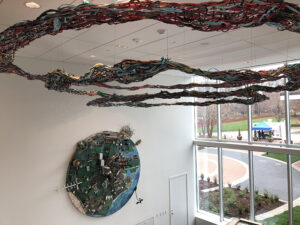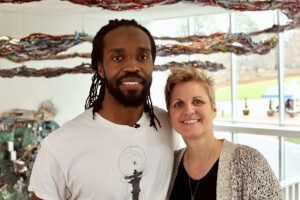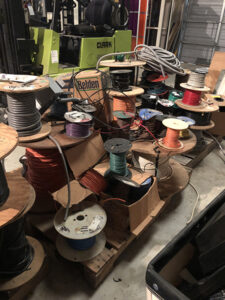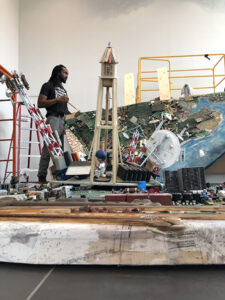 “Planet CBC.” and “Orbital Frequency” were created from recycled & found objects from the CBC archives by Durham Creator Stephen Hayes.. The art pieces now hang in the lobby at CBC’s headquarters on Western Blvd in Raleigh.
“Planet CBC.” and “Orbital Frequency” were created from recycled & found objects from the CBC archives by Durham Creator Stephen Hayes.. The art pieces now hang in the lobby at CBC’s headquarters on Western Blvd in Raleigh.
The final light fixture has been hung and adjusted, completing CBC-centric artwork almost two years in the making. Made of recycled and found objects from the Capitol Broadcasting archives, “Planet CBC” and the “Orbital Frequency” are the focal points of the new lobby at CBC’s headquarters on Western Blvd in Raleigh. The artistic brainchild of Durham Creator Stephen Hayes under direction and inspiration from CBC Audience Development General Manager Shelly Leslie, the pieces tie the many facets of CBC into one holistic visualization.
Creating a Concept
CBC undertook renovation and expansion of the outdated area of the WRAL-TV campus, which is now known as the Media Building, in March 2018. Leslie came on board the project in June 2017, which was actually well into the design phase. She was tasked with the branding for the building but that quickly expanded into being responsible for the creative direction.
She had a special focus on employee and visitor experience in the new building.
“When I first saw the drawings of the main lobby area, I thought it should be branded and positioned as CBC headquarters,” she explained.
From that sprung the idea to commission an artist to design and create a piece for the entry space.
“We’ve never had a ‘place’ where all our family of companies is represented,” said Leslie. “I felt it was an important part of CBC’s future to showcase all the different areas the company is working in our community and to visually make the connection between our companies for our staff and our visitors. Once that vision was in place, I thought the artwork needed to represent Capitol in a fresh and innovative way. I wanted it to have meaning.”
Leslie and Hayes linked through a chain of connections. She first reached out to CBC art curator and Corp/WRAL-TV Community Relations Director Loretta Harper-Arnold for insight on the local art scene.
“I had 100% commitment to hiring a local artist to continue Jim Goodmon’s tradition of showcasing local artists across CBC,” said Leslie.
CBC’s Corporate and Sales buildings are veritable galleries featuring contemporary artwork from top North Carolina artists. That collection began when those buildings were renovated in 2012-2013.
 Durham Creator Stephen Hayes & CBC Audience Development GM Shelly Leslie celebrate the installation of his art pieces “Planet CBC” and “Orbital Frequency” in the lobby of the new lobby at CBC’s headquarters on Western Blvd.
Durham Creator Stephen Hayes & CBC Audience Development GM Shelly Leslie celebrate the installation of his art pieces “Planet CBC” and “Orbital Frequency” in the lobby of the new lobby at CBC’s headquarters on Western Blvd.
Fast forward back to the latest renovation and Leslie’s need for a local artist. A former long-term WRAL-TV Creative Services employee Cindy Sink stepped in to help. She was inspired by the possibilities and volunteered as project manager to facilitate finding the right artist and managing the process of commissioning the piece. She ultimately found Hayes through a recommendation of the Durham Art Council.
Coming Together: The Ultimate Recycling Project
Leslie kept mulling over the idea of ONE CBC. In parallel with the artwork, her new CBC Audience Development team was working with Human Resources and CBC Sales to create the concept of ONE CBC for our staff and our clients.
“For our staff, we wanted to showcase what’s possible for us as a company if we think and act as ONE, instead of separate units,” she explained. “Show all of our staff the many amazing things that are happening in our family of companies. I believe this is part of our future — to harness the full power of CBC, so that’s been a tenet of AudDev since its creation.”
She continued, “For our clients and visitors, ONE CBC showcases all the ways our company serves our audiences and how we are the only local media company that can super-serve them across all platforms to reach any audience.”
In fact a video created by AudDev, focusing on all CBC divisions, now plays on a video wall in the Media Lobby, for visitors to see that wide reach and multi-faceted scope of CBC.
“These two pathways led me to the vision for the art,” said Leslie.
She immediately knew the materials that should be used to create the piece.
“I had the idea to use all ‘found objects’ from the CBC memorabilia collection as a way to represent our history but to do it in a way that felt forward thinking,” Leslie explained. “And I knew I wanted it to be dimensional, not flat. Those three bits of vision were the foundation of our interviews with the artists. Who could take that germ of an idea and create it into something spectacular?”
 Miles of old cables found at the CBC Transmitter site inspired Durham’s Stephen Hayes to create “Orbital Frequency,” an art installation for the lobby at CBC’s headquarters on Western Blvd in Raleigh.
Miles of old cables found at the CBC Transmitter site inspired Durham’s Stephen Hayes to create “Orbital Frequency,” an art installation for the lobby at CBC’s headquarters on Western Blvd in Raleigh.
When she met Hayes, she knew she was the perfect man for the job.
“Stephen’s a quiet guy but his creativity and creations speak volumes,” said Leslie. “He immediately got the vision and had ideas. I could tell from our first meeting that we would play well together and I could see from his prior work that he could think big and outside of convention and that all of his work had a narrative behind it.”
They spent hours sifting through decades of CBC detritus at the CBC Transmitter site in Auburn, NC, where warehouses store bits and pieces of just about everything you can imagine. Old tape reels, broken awards, satellite parts, antennae, miles of old cable and much more gathering dust would soon find a new very useful purpose.
Before the “treasure” gathering expedition, Leslie had shown Hayes the space in which his work would eventually hang. After seeing the outline of the lobby, the project expanded. Initially Hayes had been commissioned to do one big piece for the giant wall behind the reception desk. That piece would eventually be entitled “Planet CBC.” But he came up for an idea for an additional accompanying creation, “The Orbital Frequency”
“Stephen saw the space when it was first framed out, no sheetrock just beams, and immediately thought we needed to do some kind of installation in the ceiling,” said Leslie. “Since the CBC building team had been talking about hanging something there — we even looked at using a small helicopter body but couldn’t make it fit — we said yes him creating a second piece. When we took him to the WRAL transmitter site the first time, he saw rooms full of wire and cable in all different textures, dimension and color. He knew he wanted it immediately. A week or so later he got the AHA on what to do with it. That’s how Orbital Frequency were born.”
They culled materials from a variety of other CBC locations as well. Everything from baseball bats to blueprints became components of Hayes’ creation.
A Vision Brought to Fruition
Leslie is beyond thrilled with the final pieces, “Planet CBC” and “The Orbital Frequency.”
“I’m blown away by them,” she said. “They’re just so beyond my imagination.”
She felt the great responsibility for being in charge of a project of such long-lasting magnitude.
“In my 32 years at CBC, being part of that creation is quite possibly the thing I’m most proud of,” she said. “I’ve never commissioned artwork or been involved in the creation of a building before and I felt tremendous self-imposed pressure to create something that would honor the legacy of CBC but also live into the future. Stephen just brought it all to life.”
She is also thrilled with the reaction of employees and visitors who see the creations.
 Durham’s Stephen Hayes works on creating “Planet CBC.” The completed piece now hangs in the lobby at CBC’s headquarters on Western Blvd in Raleigh.
Durham’s Stephen Hayes works on creating “Planet CBC.” The completed piece now hangs in the lobby at CBC’s headquarters on Western Blvd in Raleigh.
“I wanted the artwork to stop people in their tracks and I love seeing it happen all day long when people come in the lobby,” Leslie said. “I wanted something people could look at and see something new every time. We could do a scavenger hunt inside Planet CBC! It’s so intricate and tells such an amazing story.”
In fact, the CBC lobby receptionists requested a laser pointer to keep at the front desk, to facilitate sharing details about “Planet CBC” with visitors.
When asked to name her favorite thing about the pieces, Leslie said, “I love the hidden meanings, the complexity and the narrative.”
She explained:
Stephen first thought about creating a ‘city,’ and we struggled for a while confined to our geographical footprint and whether we needed to do that in an overt way. Raleigh, Durham, Holly Springs, Rocky Mount, Wilmington — it’s a big area to cover. I had seen the Tiny Planet photos and thought it would feel futuristic if we used that creative tool as a guide to create a ‘planet’ instead of a state or cities. Stephen ran with it from there. The circular shape was the final key piece to making it work. Then he just had to figure out how to create the 3D elements. I also make a symbolic connection to the circles – in the planet, the rings, the light fixture – as representations of Oneness and unity, which relates back to this notion of ONE CBC and how we’re all part of something bigger than just the unit we work in.
The project at last has come full circle. And Leslie is proud of the circle of CBC staffers, construction crew members and many more who worked to fulfill the vision of ONE CBC in a tangible way in the new lobby.
“I want to thank all the people who helped me go on a 3 month scavenger hunt to find all those bits and parts and pieces that make up the Planet,” she said. “I fear I will leave someone out to try to name them all. They are all part of its creation!”
But she did mention one more CBC’er by name for his above-and-beyond contributions.
“I want to give a special shoutout to Matt Brandes, Transmitter Engineer, who was invaluable during this whole CBC artifact scavenger hunt!” said Leslie. “He helped us find all kinds of treasure at the transmitter that we ultimately used in the artwork. So grateful for Matt’s institutional knowledge and knowing where all the gold is buried.”
Thanks to AUD’s Shelly Leslie for these capcom photos & for this capcom video.
SLIDESHOW: “Planet CBC” and “Orbital Frequency” by Durham Creator Stephen Hayes
Durham’s Stephen Hayes works on creating “Planet CBC.” The completed piece now hangs in the lobby at CBC’s headquarters on Western Blvd in Raleigh.
Durham’s Stephen Hayes works on creating “Planet CBC.” The completed piece now hangs in the lobby at CBC’s headquarters on Western Blvd in Raleigh.
A close-up of “Planet CBC,” the art installation created by Durham’s Stephen Hayes. The piece hangs in the lobby at CBC’s headquarters on Western Blvd in Raleigh.
A close-up of “Planet CBC,” the art installation created by Durham’s Stephen Hayes. The piece hangs in the lobby at CBC’s headquarters on Western Blvd in Raleigh.
“Planet CBC” in progress. The completed art installation by Durham Creator Stephen Hayes now hangs in the lobby at CBC’s headquarters on Western Blvd in Raleigh.
“Planet CBC” in progress. The completed art installation by Durham Creator Stephen Hayes now hangs in the lobby at CBC’s headquarters on Western Blvd in Raleigh.
Durham’s Stephen Hayes works on creating “Planet CBC.” The completed piece now hangs in the lobby at CBC’s headquarters on Western Blvd in Raleigh.
The water tower at Rocky Mount Mills served as an inspiration for the “Planet CBC” mixed media art piece created by Durham artist Stephen Hayes.
Durham’s Stephen Hayes works on creating “Planet CBC.” The completed piece now hangs in the lobby at CBC’s headquarters on Western Blvd in Raleigh.
Miles of old cables found at the CBC Transmitter site inspired Durham’s Stephen Hayes to create “Orbital Frequency,” an art installation for the lobby at CBC’s headquarters on Western Blvd in Raleigh.
Miles of old cables found at the CBC Transmitter site inspired Durham’s Stephen Hayes to create “Orbital Frequency,” an art installation for the lobby at CBC’s headquarters on Western Blvd in Raleigh.
Scaffolding is erected for the installation of the rings of “Orbital Frequency,” the art piece created by Durham’s Stephen Hayes. The piece hangs in the lobby at CBC’s headquarters on Western Blvd in Raleigh.
Scaffolding is erected for the installation of the rings of “Orbital Frequency,” the art piece created by Durham’s Stephen Hayes. The piece hangs in the lobby at CBC’s headquarters on Western Blvd in Raleigh.
Scaffolding is erected for the installation of the rings of “Orbital Frequency,” the art piece created by Durham’s Stephen Hayes. The piece hangs in the lobby at CBC’s headquarters on Western Blvd in Raleigh.
Scaffolding is erected for the installation of the rings of “Orbital Frequency,” the art installation created by Durham’s Stephen Hayes. The piece hangs in the lobby at CBC’s headquarters on Western Blvd in Raleigh.
Workers on scaffolding install the rings of “Orbital Frequency,” created by Durham’s Stephen Hayes. The piece hangs in the lobby at CBC’s headquarters on Western Blvd in Raleigh.
Creator Stephen Hayes (left) works with the construction crew on scaffolding to install the rings of “Orbital Frequency,” the art piece he created for the lobby at CBC’s headquarters on Western Blvd in Raleigh.
Workers on scaffolding install the rings of “Orbital Frequency,” created by Durham’s Stephen Hayes. The piece hangs in the lobby at CBC’s headquarters on Western Blvd in Raleigh.
Creator Stephen Hayes (left) works with the construction crew on scaffolding to install the rings of “Orbital Frequency,” the art piece he created for the lobby at CBC’s headquarters on Western Blvd in Raleigh.
Workers on scaffolding install the rings of “Orbital Frequency,” created by Durham’s Stephen Hayes. The piece hangs in the lobby at CBC’s headquarters on Western Blvd in Raleigh.
Workers on scaffolding install the rings of “Orbital Frequency,” created by Durham’s Stephen Hayes. The piece hangs in the lobby at CBC’s headquarters on Western Blvd in Raleigh.
Workers on scaffolding install the rings of “Orbital Frequency,” created by Durham’s Stephen Hayes. The piece hangs in the lobby at CBC’s headquarters on Western Blvd in Raleigh.
Workers on scaffolding install the rings of “Orbital Frequency,” created by Durham’s Stephen Hayes. The piece hangs in the lobby at CBC’s headquarters on Western Blvd in Raleigh.
AUD’s Anita Normanly watches the installtion of the rings of “Orbital Frequency,” created by Durham’s Stephen Hayes. The piece hangs in the lobby at CBC’s headquarters on Western Blvd in Raleigh.
Creator Stephen Hayes (left) works on scaffolding to install the rings of “Orbital Frequency,” the art piece he created for the lobby at CBC’s headquarters on Western Blvd in Raleigh.
Creator Stephen Hayes and project manager Cindy Sink make adjustments scaffolding to install the rings of “Orbital Frequency,” the art piece he created for the lobby at CBC’s headquarters on Western Blvd in Raleigh.
The installation of the rings of “Orbital Frequency,” created by Durham’s Stephen Hayes, is complete. The piece hangs in the lobby at CBC’s headquarters on Western Blvd in Raleigh.
Installation is completed on “Orbital Frequency,” the art piece Durham Creator Stephen Hayes created for the lobby at CBC’s headquarters on Western Blvd in Raleigh.
Installation is completed on “Orbital Frequency,” the art piece Durham Creator Stephen Hayes created for the lobby at CBC’s headquarters on Western Blvd in Raleigh.
“Planet CBC” is ready for installation. The completed art piece by Durham Creator Stephen Hayes now hangs in the lobby at CBC’s headquarters on Western Blvd in Raleigh.
Installation begins on “Planet CBC.” Durham Creator Stephen Hayes created the piece from recycled & found objects from the CBC artchives. The completed art piece now hangs in the lobby at CBC’s headquarters on Western Blvd in Raleigh.
Installation is completed on “Planet CBC.” Durham Creator Stephen Hayes created the piece from recycled & found objects from the CBC artchives. The completed art piece now hangs in the lobby at CBC’s headquarters on Western Blvd in Raleigh.
“Planet CBC” and “Orbital Frequency” were created from recycled & found objects from the CBC archives by Durham Creator Stephen Hayes.. The art pieces now hang in the lobby at CBC’s headquarters on Western Blvd in Raleigh.
“Planet CBC” and “Orbital Frequency” were created from recycled & found objects from the CBC archives by Durham Creator Stephen Hayes.. The art pieces now hang in the lobby at CBC’s headquarters on Western Blvd in Raleigh.
“Planet CBC.” was created from recycled & found objects from the CBC archives by Durham Creator Stephen Hayes.. The art piece now hangs in the lobby at CBC’s headquarters on Western Blvd in Raleigh.
Durham Creator Stephen Hayes created “Planet CBC.” from recycled & found objects from the CBC archives.. The art piece hangs in the lobby at CBC’s headquarters on Western Blvd in Raleigh.
The quote from CBC Founder A.J. Fletcher completes the new lobby at CBC’s headquarters on Western Blvd. “Orbital Frequency” (above) were created from recycled & found objects from the CBC archives by Durham Creator Stephen Hayes..
“Planet CBC.” and “Orbital Frequency” were created from recycled & found objects from the CBC archives by Durham Creator Stephen Hayes.. The art pieces now hang in the lobby at CBC’s headquarters on Western Blvd in Raleigh.
“Planet CBC.” and “Orbital Frequency” were created from recycled & found objects from the CBC archives by Durham Creator Stephen Hayes.. The art pieces now hang in the lobby at CBC’s headquarters on Western Blvd in Raleigh.
“Planet CBC” and “Orbital Frequency” were created from recycled & found objects from the CBC archives by Durham Creator Stephen Hayes.. The art pieces now hang in the lobby at CBC’s headquarters on Western Blvd in Raleigh.
A view of “Planet CBC” and “Orbital Frequency” post-installation from outside. The art pieces were created from recycled & found objects from the CBC archives by Durham Creator Stephen Hayes and now hang in the lobby at CBC’s headquarters on Western Blvd in Raleigh.
A view of “Planet CBC” and “Orbital Frequency” post-installation from outside. The art pieces were created from recycled & found objects from the CBC archives by Durham Creator Stephen Hayes and now hang in the lobby at CBC’s headquarters on Western Blvd in Raleigh.
A light fixture is added to completed the look of “Orbital Frequency,” the art piece Durham Creator Stephen Hayes created for the lobby at CBC’s headquarters on Western Blvd in Raleigh.
A light fixture is added to completed the look of “Orbital Frequency,” the art piece Durham Creator Stephen Hayes created for the lobby at CBC’s headquarters on Western Blvd in Raleigh. His creation ‘Planet CBC” hangs on the wall.
A light fixture is added to completed the look of “Orbital Frequency,” the art piece Durham Creator Stephen Hayes created for the lobby at CBC’s headquarters on Western Blvd in Raleigh.
Durham Creator Stephen Hayes & CBC Audience Development GM Shelly Leslie celebrate the installation of his art pieces “Planet CBC” and “Orbital Frequency” in the lobby of the new lobby at CBC’s headquarters on Western Blvd.
More About Stephen Hayes
North Carolina born, Stephen Hayes was raised to the idea that anything is possible; if you dream it you can do it. In 2006 he earned his BFA in Visual Communication from North Carolina Central University. After attending North Carolina Central University in 2007 Stephen received a full summer scholarship to New York State College of Ceramics at Alfred University. Following his studies at Alfred University. In 2008 Stephen began a Masters Of Fine Art at Savannah College of Art and Design in Atlanta, and received his MFA, May 2010. After SCAD, Stephen began teaching on a college level, and attending a number of residencies, while touring his exhibitions. Currently Stephen is touring his MFA thesis exhibit Cash Crop and adding new elements to the exhibition each stop. In addition to that Stephen, is currently touring new exhibitions and working to create his new work and commissions.
Creator’s Statement
As a creator my goal at first thought is to wow my audience. I enjoy collecting objects create interesting and amazing compositions. This goes back to my childhood, when my mom would bring old machines home from work and allow me to make things with them. That’s what started me making art, started creating. As a creator my favorite process is adapting to material and learning new process. I use materials that are at my disposal and combined the skills that I learned over the years to create my art. Not only do I strive to create something that will be visually stimulating the work must have a meaning. With my art I like to take a subject from the past and compare it to the present. The subjects my artwork revolves around brainwashing, capitalism, and commodity. Throughout my work you will see a horse, corn, or a pawn. The horse imagery comes from the ideology if the Willie Lynch letter, “How to Make a Slave” in that letter the breaking of a slave was compared to the breaking of a horse. I see this in the media where people are being broken mentally to want to buy materialistic things. Corn is a G.M.O (genetically modified organism) and the corn that I use is made of the broke slave ship plan. I use the corn to ask, how are as people G.M.Os? I use the pawn because I feel that some people in the media are pawns, they are put here to attract people as a form of brainwashing.
CBC Planet
Mixed Media, Mother boards, Metal, Wood, Resin, Paint
2019
Orbital Frequency
Wire
2019